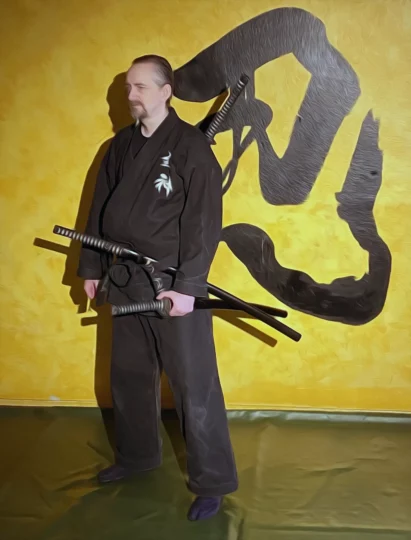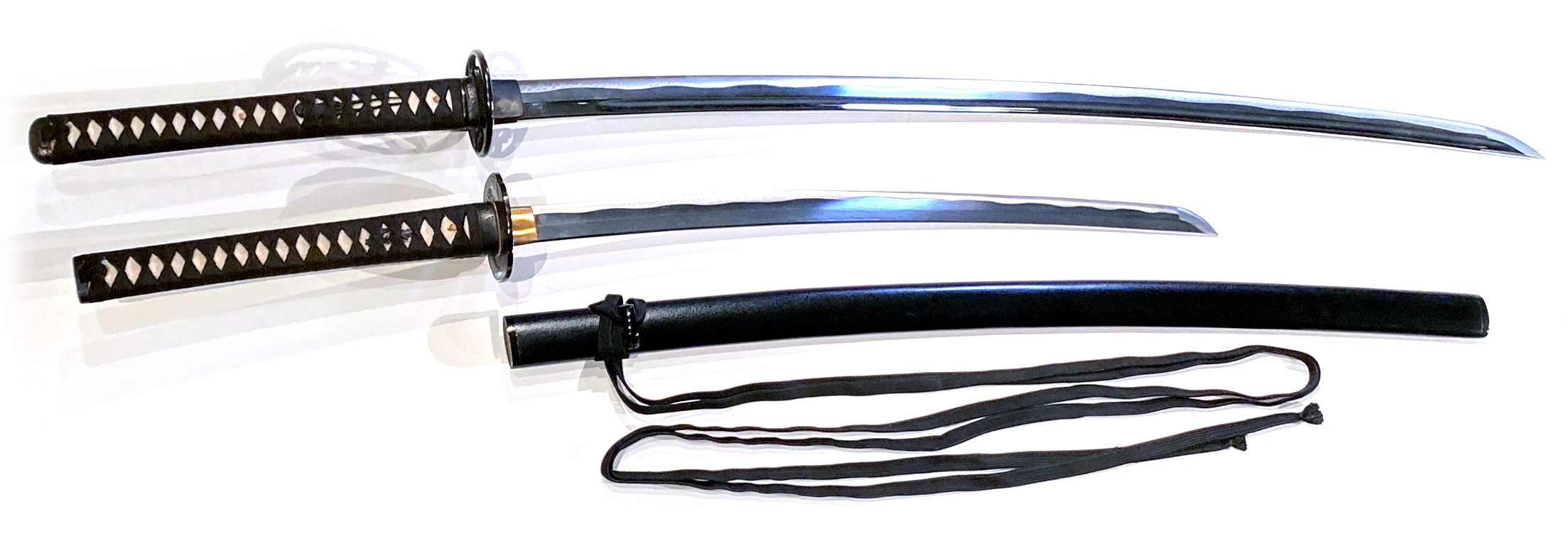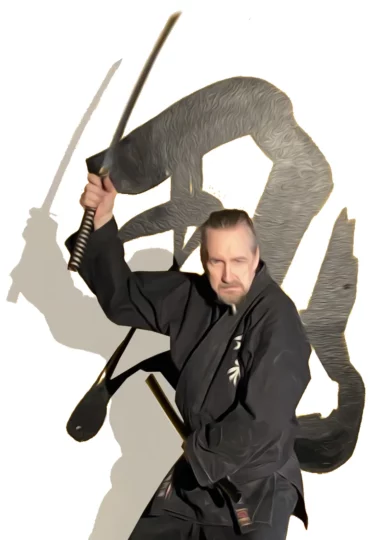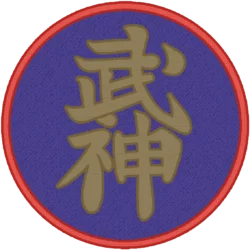忍刀 NINJA-TŌ / SHINOBI-GATANA

The Ninja-tō has a long Sageo (cord), but the blade is shorter than the Saya (scabbard). The sword is usually between 1-2 Shaku (30-60 cm/1-2 ft). The Kojiri (scabbard tip) was enforced, sometimes filled with lead. The Tsuka (handle) looked like a normal Katana, the Tsuba was not necessary square. And it was very important that the sword did not stand out when it was carried in the belt.
The blade was sometime coated in oily ink to eliminate reflection. Metsubushi (blinding powder) or secret documents could be hidden inside the bottom of the Saya.
Then we have the Shichinin-tō, it was a blade that was jagged like a saw. And many variations where the sword was hidden inside ordinary looking staffs.
忍刀 NINJA-TŌ
The characteristic straight Ninja sword with square Tsuba portrayed by Hollywood films is probably not historically accurate. The first known description of this type of sword is from the booklet by Heishichirō Okuse from 1956. There is no older sources for this type of sword as “the Ninja sword”.

忍大刀 NINJA DAITŌ
The the long Ninja sword is Sanshaku (91 cm/3 ft) long. I don’t know much about the use of this type of sword in Togakure-ryū. It seems to be more of a battle field weapon because it would be rather clumsy to carry on “night missions.”
忍者の剣は闇夜の剣をかいくぐる
(Ninja no ken wa yamiyo no ken o kaikuguru)
“The sword of the Ninja evades the sword of the dark night“
The character for darkness here is opening the gate of the mysteries and listening- because the character for “sound 音” is surrounded by the character for “gate 門” in the character for “darkness 闇”. Shinobu silence isn’t striking Kyusho (vital part), but dropping them to the floor.
Without a sound, when striking, in my Shin-Gi-Tai, an echo responding to truth transmitted from deep inside, the following great-transmitted principles must be further polished. Within this is the allusion to the Raiko no Ken (sword of lightning) and Issen Ken (flashing sword). In other words, if you call darkness the sound of day, you are connecting the two.
Not in the 距離 Kyo-ri (distance)
Not in the 巨利 Kyo-ri (gain)
Not in the 虚理 Kyo-ri (false principles)
Only in 忍識 Ninshiki (perseverance)
戸隠流秘剣術 TŌGAKURE-RYŪ BIKENJUTSU
Shinobi no Kenpō was born out of human conflict that changed the course of history and, being essentially connected with the five influences of…

1. 棒術 Bōjutsu (stick fighting)
2. 青銅の剣 Seidō no Ken (bronze sword)
3. 鉄の剣 Tetsu no Ken (iron sword)
4. 太刀 Tachi (long sword)
5. 刀 Katana (sword)
And it became a cord of connection from which the secrets of Shinobi no Ittō were formed.
Then, beginning with Ichi no Kamae, then Tōsui no Kamae, Ihen no Kamae, Seigan no Kamae, Tongata no Kamae, Ittō Nage, Ittō Ryūdan, Ittō Giri, Kirikaeshi, Sutemi, Kage no Kiai, and Shinobi no Kanpa-jutsu, one can produce incredible things.
If one’s energy flows with the tides, bringing Heaven, Sky, and Earth together, the five faces, like a dancing dragon, together with one’s whole body, and if this becomes the retreating form of a god neither true nor false (without Kyōjitsu), the radiance of the opening of the great stone door of the Shinobi no Mono who possesses awareness will project the great illusion that bestows the light of enlightenment in the spirit of the Shinobi no Mono onto the screen.
Shinobi no Ken is a treasure chest of never-ending change. Obtaining the Ninki (persevering spirit) of the Happō Biken of Banshu Shukai, along with the spirit of intent (life), one observes unexplored regions of the essence of the illusory fog that vanishes into the mist of the treasure chest.
The secret song is as follows:
Win without drawing the sword
If you draw it, don’t cut
Simply persevere
Know the significance Of taking a life
忍刀秘剣 NINJA-TŌ BIKEN
1. 忍者刀 NINJATŌ
2. 帯刀 TAITŌ
居合 IAI
1. 目潰し METSUBUSHI
2. 片手抜 KATATE NUKI
3. 鯉口切 KOIKUCHI KIRI
4. 居合間合 IAI MAAI
5. 影之一刀 KAGE NO ITTŌ
One of many videos we recorded at Kaigozan Dojo. Here I show the eight Kamae and the corresponding technique belonging to the Kamae. Download it here.
構 KAMAE
1. 一之構 ICHI NO KAMAE
2. 正眼之構 SEIGAN NO KAMAE
3. 中段之構 CHŪDAN NO KAMAE
4. 下段之構 GEDAN NO KAMAE
5. 棟水之構 TŌSUI NO KAMAE
6. 八相之構 HASSŌ NO KAMAE
7. 霞之構 KASUMI NO KAMAE
8. 刀匿礮姿 TŌTOKU HYŌSHI
一刀投 ITTŌ NAGE
一刀榴弾 ITTŌ RYŪDAN
This video I show the six fundamental Ninja-tō techniques with variations. Download it here.
八方秘剣 HAPPŌ BIKEN
1. 飛龍之剣 HIRYŪ NO KEN
2. 霞之剣 KASUMI NO KEN
3. 無想剣之構(浦波) MUSO KEN NO (URA NAMI)
4. 打とう之構 DATŌ NO KEN
5. 一閃剣 ISSEN KEN
6. 雷光之剣 RAIKŌ NO KEN
